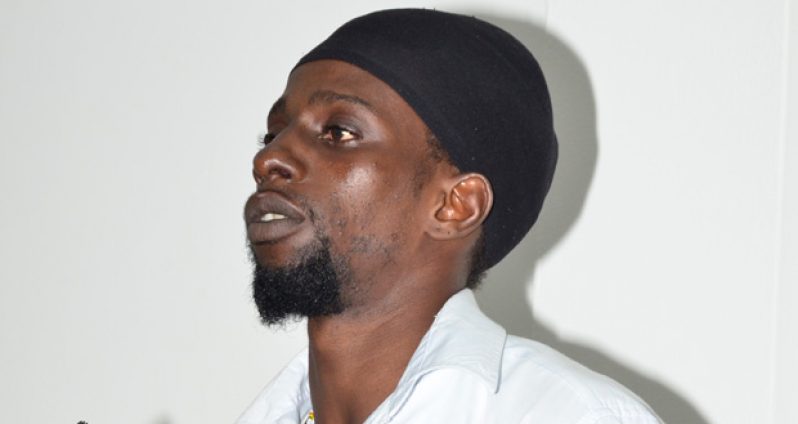By Ariana Gordon
MURDER accused Owen Belfield testified on Friday before the Commission of Inquiry (CoI) into the Georgetown Prison riots that he never saw prison officials beating inmates on March 3, in the compound of the Camp Street penitentiary.Belfield was at the time being cross-examined by Dexter Todd, who asked him to recount what had transpired on March 3 at the prison. The prisoner told the three-man Commission that following the instructions of the Prison Authority, he attempted to make his way through the front door of Capital ‘A’ Division, but by the time he arrived at that location an instruction had been passed for the door to be locked.

The prisoner who has been on remand for 11 months told the Commission that after the door was locked, based on the instruction of “Mr Heyliger,” he proceeded to his “bed space.” He made it clear that though he heard other prisoners stating that those who left Capital ‘A’ earlier were being beaten when they got downstairs and his decision to return to his “bed space” had nothing to do with that.
“You went back in because the other inmates were being beaten?” asked Todd and Belfield replied, “No Sir, I didn’t come out the building – I was just in front the door.”
The prisoner explained that the front door was open as he was approaching it and from where he was, he could have seen into the yard.
“Did you look into the yard?” the attorney representing the interests of Delroy Williams and Marcellos Verbeke asked.
“Yes sir,” Belfield replied, after which he was asked by Todd to state what he saw. “Prisoners were being searched and the taskforce were taking away one of the prisoners… carrying him to the front of the yard.”
Asked whether he saw inmates being beaten by the prison officers or wardens on March 3, “at the time I didn’t see no inmates being beaten…they were carrying them away.”
The attorney followed up by asking Belfield if he did not see his fellow inmates being beaten, why did he believe the words of the prisoners who retreated into the prison. “Sir I didn’t believe…I was coming out and the door lock in my face.”
The prisoner explained that he was prevented from leaving the Capital ‘A’ Division and did not refuse to leave because of what the other inmates had stated. Additionally, the prisoner said his fellow inmates were not angry or rowdy on March 3.
“So you would want this Commission to believe that persons were ordered to come out of the cell, some refused to come out because of the fact that others were being beaten… an order was made to lock back the door… a fire started in Capital ‘A’… you saw no prison officer come into Capital ‘A’ and you would say that is a calm situation? Sir listen, you have to be respectful to yourself.”
Todd’s suggestion to the prisoner was objected to by both counsel for the Prison Service and Police, Selwyn Pieters and Chairman of the CoI Justice James Patterson.
Meanwhile, Pieters during his cross-examination of Belfield suggested that he (Belfield) and Collis Collison are close friends.
“For the purpose of your friends in prison you were tight with Collis Collison,” said Pieters. “No sir,” replied Belfield who was later confronted with the fact that he took a photo with Collison that was later posted to Facebook.
“Let me ask you this, have you ever posed for pictures with Collis Collison while you were in jail?”
“Yes sir,” the prisoner replied. He was then asked to state who took the photo of him and Collison and it was then that it was revealed that Collison had taken the photograph with his mobile device.
“He tek it with a phone sir,” replied Belfield. Pieters then informed the prisoner that the photograph of him and Collison was uploaded to the social media site. At that point, the prisoner admitted to having a Facebook account but said he did not know that Collison had posted the photograph to Facebook.
“I am going to tell you that your picture is on Facebook… Mr Chairman, I was hoping that we would get colour pictures that I could have presented to the tribunal and give copies to counsel, but the prison wasn’t able to get coloured copies,” said the attorney.
But Belfield during his questioning made it clear that he had taken only one photograph with Collison. “It was only one time sir.”
COLLISON’S FACEBOOK PAGE
Meanwhile, a search of Collison’s Facebook page saw several photographs with Collison while in the Georgetown Prison sporting mobile phones, and marijuana.
A photograph of a gun and ammunition posted on August 12, 2015 was also evident on his page; photos of Collison with packets of marijuana along with photographs of Collison’s inmates in the Georgetown Prison. The latter photographs were all posted on January 25 this year.
Pieters then put it to Belfield that contrary to what was stated yesterday by fellow inmate Desmond James that he never saw mobile phones in prison, that phones were indeed in the penitentiary.
“You’d agree that cellphones were in Capital ‘A’?” “Yes sir,” replied Belfield, who was then asked “you’d agree as well that marijuana was in Capital ‘A’? “Yes sir.”
The prisoner, however, denied seeing photographs of large packs of marijuana being placed on Facebook by Collison. He also denied knowing that marijuana was “trafficked by certain inmates

within that cell block.”
Belfield did acknowledge the presence of weapons in Capital ‘A’ and said while he was unaware of the presence of cutlasses and sharp ice picks in the Camp Street jail, he is familiar with “sharpened toothbrushes.”
He was also asked whether he witnessed inmates breaking the bunk beds provided by the State to use the metal to make weapons. The murder accused denied being aware of such occurrences.
GLASS BOTTLES NOT ALLOWED
Meanwhile, Belfield told the Commission that glass bottles are not allowed in the Camp Street jail. He said for the 11 months he was in the penitentiary he has never seen glass bottles allowed. He explained that plastic bottles are allowed into Capital ‘A’ Division of the prison.
Attorney Todd questioned Belfield on the process by which items enter the facility. The prisoner noted that all items that are coming from outside of the facility enter only after a thorough search by prison wardens.
Holding on to the premise that only plastic bottles are allowed in the prison, Todd asked, “If you hear the theory that a cork was placed at the keyhole from the inside of the cell while the fire was in there, what would you expect to happen to the cork?”
Belfield replied, “Sir the cork would melt.” Pieters in his cross-examination of Desmond James on Thursday stated that the prisoners placed a cork in the keyhole of the door and that prevented the prison authority from being able to open the main door during the fire.
“Yes sir, plastic do burn sir,” said Belfield.
RINGLEADER
The prisoner was then asked to identify the ringleader within Capital ‘A’, whom he identified as “Jermaine.”
“Who was the ringleader in Capital ‘A’?” asked Todd, who was told “I don’t know sir”. The attorney rephrased his question after recognising that the prisoner did not understand what he was asking.
“Who was the person in Capital ‘A’ who carried the weight?”
“Sir we have an orderly…his first name is Jermaine Sir…I ain’t know he last name,” Belfield replied, while adding that the orderly was not at the prison on March 3.



.jpg)








